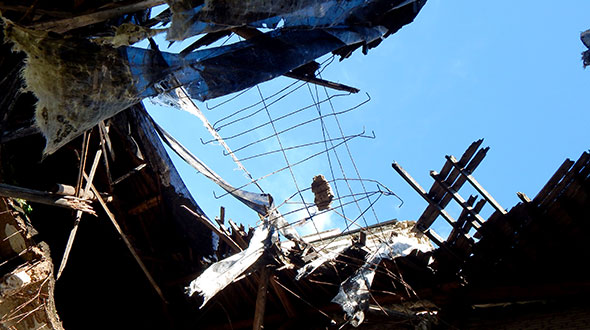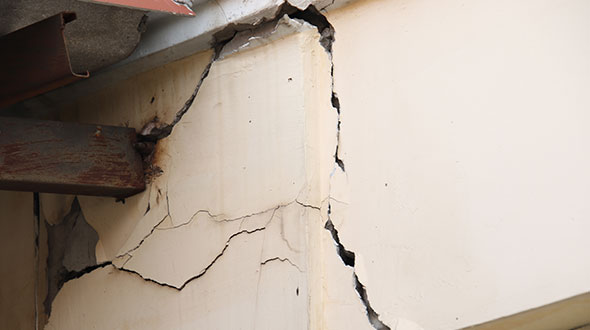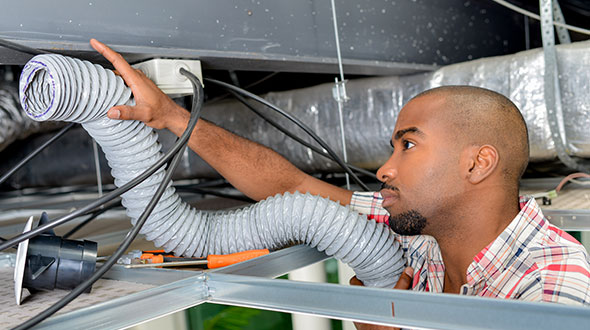
Avoid catastrophic financial loss and indefinite business closure from a collapsed roof at your building or commercial property. By knowing the signs that indicate an imminent roof collapse, and what preventative measures you can take.
atlantacommercialroofingcontractors.com gathered information about the signs that precede a roof collapse and what you can do to prevent it.
Sagging Roof or Ceiling
Contact your roofing company immediately if your ceiling and/or roof starts to sag. This is an alarming sign of structural failure that needs to be investigated and corrected before your roof fails altogether.
If you do not have a roofer, read Commercial Roof Repair, Insurance Claims, and Hiring Contractors to learn what qualifying questions to ask and what attributes to look for when hiring a roofing contractor.
My Roof Is Leaking or Signs of Water on the Ceiling
A leaking roof is never a good sign. Roof leaks are evidence that water is reaching your roof’s support structure and potentially causing devastating damages.
Once you spot a leak, you should have your roofer identify the source and evaluate the extent of structural damage sustained, if any.
Note: Any time your roof is leaking is cause for alarm. This problem needs to be fixed fast.
Sprinkler Heads and Ceiling Tiles Out of Alignment
If you notice your ceiling tiles or sprinkler heads out of alignment, your ceiling has shifted. Your ceiling isn’t supposed to move. If you notice a misalignment of your ceiling tiles or sprinklers, you need to find out why and correct it fast.
Doors and Windows Have Become Difficult to Open or Close
Similar to ceiling tiles or sprinkler heads out of alignment, if your doors and windows have become increasingly difficult to open or close, structural shifting has likely occurred.
If this is the case, this shifting can cause your roof’s support system to buckle and fail. Ironically, when you detect a problem with doors and windows, immediately call your roofer.
Cracks in The Exterior Walls of The Building
Cracks in the masonry on the exterior of your building are a clear indication that something is terribly wrong structurally. Among other possibilities, it could be a signal that your roof has become unstable and nearing failure.

To avoid catastrophic damages, have the building engineers inspect the structure and get your roofer on the scene to evaluate the integrity of the roof.
Note: Cracks in the interior walls, support columns, and/or ceiling also indicate severe structural problems. These cracks don’t happen without reason and should be promptly investigated.
Severe Weather Damage
Depending on the region you are located in, many weather-related factors can cause or contribute to the failure of your roof:
• Hurricanes
• Tornadoes
• Wind Storms
• Hail Storms
• Wildfires
• Snow Accumulation
• Extreme Temperature Fluctuations
Your roof should be inspected immediately following such weather events. In fact, if you have enough advance warning, have your roof thoroughly examined beforehand.
Note: If you live in areas prone to specific weather events, make sure that your roof/building insurance will cover damages from such events.
Read more about insurance claims following storm damage at atlantacommercialroofingcontractors.com/commercial-roof-storm-damage-insurance-claims/
New Equipment Installation
The installation of new or updated equipment on your roof may add considerable weight to it. In some cases, you may exceed your commercial roof load and put the integrity of your roof and building at risk.

When planning to install equipment on your roof, calculate your roof’s dead load, live load, and transient load capacity to avoid exceeding your total roof load capacity.
Read more about why you should know your commercial roof load at atlantacommercialroofingcontractors.com/what-is-commercial-roof-load-why-you-need-to-know/
Ponding Water
Ponding water may occur from clogged drain systems, a poorly installed roof, or a poorly maintained roof. Regardless of the reason, ponding water adds an incredible amount of weight to your roof structure.
In fact, one gallon of water weighs 8.34 pounds (100 gallons of rainwater can add 834 pounds of dead weight to your roof). When this water accumulates and persists, your roof’s load may be exceeded and lead to its failure.
Creaking and Popping Sounds
Some people believe that popping and creaking sounds are normal in buildings and simply dismiss them. Never assume that your building is just settling. If you hear these types of sounds, have your building engineer and roofer investigate them immediately, they may be occurring because of structural defects or failure.
The Building Has Shifted
If the following signs occur, it may be an indication that your building has shifted:
• The floors have become uneven
• The building “feels” like it has tilted
• Support columns and vertical installations appear to be angled
If your building has shifted on a structural level, there is a risk that your roof will suffer complete failure. Not to mention the risk of your building collapsing.
When the signs mentioned above are noticed, even in the slightest, your building engineer should be called to immediately investigate the cause.

Commercial Roof Collapse
If your commercial roof collapses, you will be forced to stop all production and completely close the building until your roof is replaced, and OSHA inspectors allow its occupation.
Your insurance claim can be denied if the insurance adjuster finds that the collapse was due to a lack of maintenance or a structural failure that could have been prevented.
Read about why commercial roofing maintenance programs are necessary and how they save you money at atlantacommercialroofingcontractors.com/maintenance-programs-services/
Signs of A Potential Roof Collapse
In this article, you discovered many of the signs that indicate an imminent roof collapse and what you can do to prevent it from happening.
By recognizing roof failure warning signs and promptly resolving them, you are protecting your business’ assets and avoiding a potentially lethal situation.
Your failure to act on signs of your roof’s structural failure can result in catastrophic production and financial losses when the roof collapses.
Sources:
eng-resources.uncc.edu/failurecasestudies/building-failure-cases/hartford-civic-center/
fo.umich.edu/pdf/Protecting_Buildings_from_Freeze.pdf
web.wpi.edu/Pubs/E-project/Available/E-project-081409-132533/unrestricted/IQP-Final.pdf
citeseerx.ist.psu.edu/viewdoc/download?doi=10.1.1.531.7105&rep=rep1&type=pdf

No comments:
Post a Comment
Note: Only a member of this blog may post a comment.